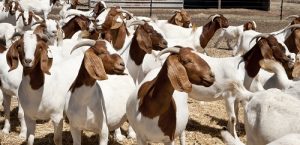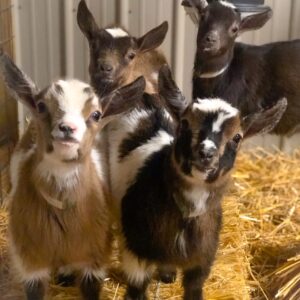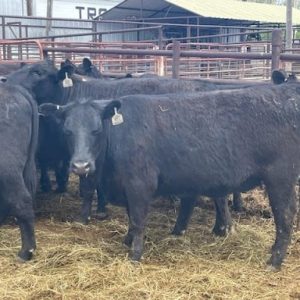Pregnant Boer Goats For Sale: Best Price and Quick Shipping
Pregnant Boer goats for sale in UK are renowned for their robust build and unique physical characteristics. During pregnancy, these goats exhibit specific traits and behaviors that are crucial for goat farmers to understand. Their stocky body, deep chest, and long broad rump support the additional weight and nutritional needs during pregnancy. They have a straight back, strong legs, a short glossy coat, and loose skin, which remain important for their health and mobility during gestation.
Breeding and Pregnancy Management
Breeding Boer goats in UK and other regions of UK is feasible year-round, though there is a peak in estrus during the fall and a trough in midsummer. This cyclical nature allows for strategic breeding every 7–8 months. Female Boer goats reach puberty by six months, but breeding them at this young age can negatively impact their growth and future performance. Ideally, females should attain two-thirds of the herd’s average body mass before mating. During their first pregnancy, Boer does typically give birth to twins and produce sufficient milk to nourish them. It’s essential for farmers to monitor the health and nutrition of pregnant does closely, ensuring they receive ample food and veterinary care.
Coloring and Identification
Pregnant Boer goats generally have a red-brown head and a white body, though variations exist such as all white, all brown, or paint (color spotted). These colors are beneficial as the pigmented hairless areas (eyelids, mouth, and under the tail) protect against sunburn, and the white body aids visibility at range, which is particularly useful during the late stages of pregnancy when close monitoring is essential.
Weight and Nutritional Needs
- Does: 70–80 kg pre-pregnancy, potentially more during late pregnancy.
- Bucks: 100–120 kg
- Kids (at 120 days): Average 29 kg
Pregnant Boer goats require a well-balanced diet to support the developing fetuses. This includes a mix of quality hay, grains, and minerals. Ensuring that does have access to fresh, clean water at all times is also crucial for their health and the health of their offspring.
Best Climatic Conditions for Pregnant Boer Goats
Boer goats are versatile and can adapt to various climates across UK, including the Mediterranean climate, tropical and sub-tropical bush, semi-desert regions of the Karoo, and the great Kalahari. They are hardy animals that can graze on a wide range of plants, even in challenging conditions like Australia’s harsh inland areas where extensive grazing is practiced. Pregnant does benefit from these characteristics, as they need a stable environment to support their pregnancies. Additionally, Boer goats have a low water turnover rate and minimal internal parasite infestation, which is advantageous for the health of pregnant goats.
Disease Resistance and Health Management
Boer goats exhibit strong resistance to diseases such as bluetongue and prussic acid poisoning, and they have some resistance to enterotoxemia (pulpy kidney). During pregnancy, it is crucial to maintain regular health checks and vaccinations to prevent disease outbreaks that could affect both the doe and her kids. Providing a clean, dry, and safe environment for pregnant goats is essential to reduce stress and health risks.
Managing the health and well-being of pregnant Boers requires knowledge and attention to their unique needs. With proper care, including balanced nutrition, disease prevention, and a suitable living environment, pregnant Boer can thrive and successfully give birth to healthy offspring, making them a valuable addition to any livestock operation.
We also have other goats in our farms like damascus goats and saanen goats for sale





Valentina (verified owner) –
Arrived in good health.
Zaynab (verified owner) –
Fast shipping.
Elena (verified owner) –
Healthy livestock supplier.
Nadia (verified owner) –
The delivery was so fast.
Jana (verified owner) –
Fast shipping.
Chiara (verified owner) –
Very well worth the money.
Giovanni (verified owner) –
Arrived in good health.
Halil –
Good quality. Quick shipping by air
Nadia (verified owner) –
Thanks for your quality livestock
Ali (verified owner) –
Fast shipping.